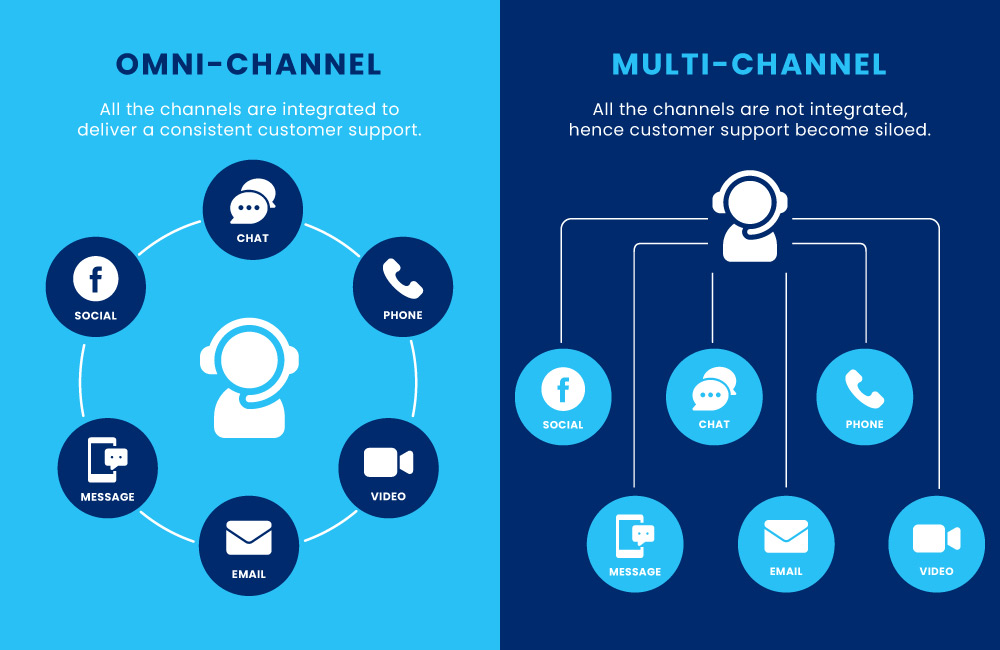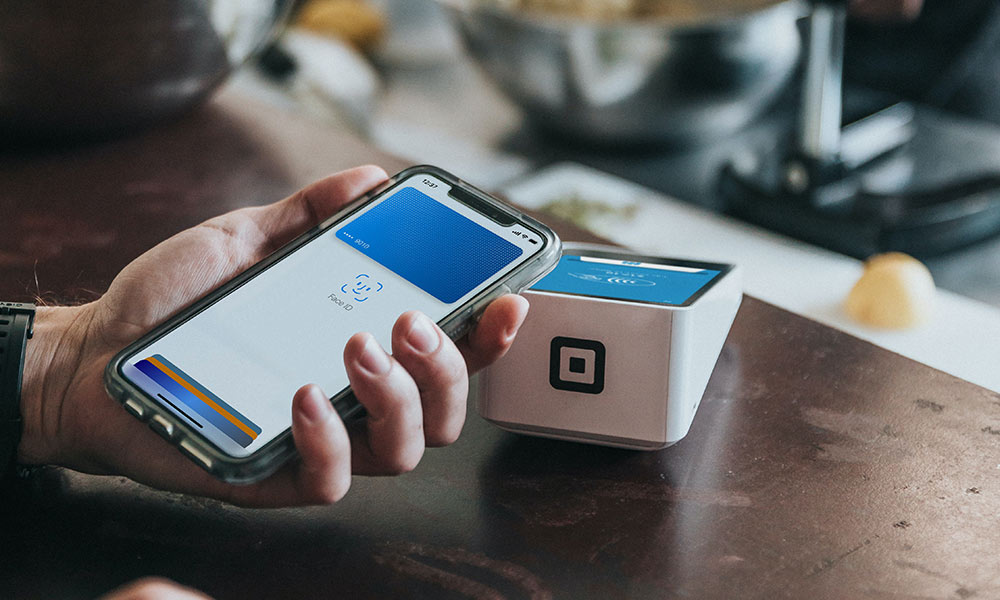Omni-Channel Marketing: The Ins & Outs, Do's & Don'ts

Omnichannel marketing is more than a strategy; it's a mindset. It's something that shoppers who shop anywhere and everywhere expect. They expect you to be available at all times — on their phone, over email and SMS, via live chat, and in a real store.
However, marketers have had difficulty grasping the concept of multichannel. Let us attempt to make sense of it.
The omnichannel idea has always been based on the concept of all – 'Omni' in Latin. Therefore, the features of omnichannel would be: spanning data, traversing channels, and engaging with people at all times and in all places.
Let’s start with some facts.
Did you know that 86% of buyers switch between two channels regularly?
They don't just jump from one store to the next; they shop across numerous channels as well.
They may make online purchases while waiting in line at a physical store, or they may use cell phones as shopping assistants in stores.
As a result, 87% of retailers consider omnichannel marketing to be critical to their success.
They understand that to stay on top of their game, they must provide customers with a consistent experience across all touchpoints.
As a retailer, you must recognise the importance of omnichannel marketing to your business and use it to provide a unique experience for your customers while increasing your ROI.
So, we have to ask:
What Is Omnichannel Marketing?
Omnichannel marketing is the practice of establishing your brand's presence across multiple online (website, app, social media, email, SMS, WhatsApp) and offline (retail store, events, call-centre) channels while ensuring a positive and seamless customer experience throughout the customer journey.
As customers progress down the sales funnel, omnichannel marketing is the seamless integration of branding, message, and online and physical touchpoints, resulting in a more positive customer experience.
The words 'positive' and ‘seamless' are important to note because 67% of customers cite poor customer service as a reason for churn. So, if you want to win and keep customers, you must take your omnichannel marketing strategy seriously and strengthen it to provide a positive experience to your customers throughout their journey.

Omnichannel marketing is a consumer-centric approach to marketing. From social media to customer care hotlines, consumers may now communicate with brands in a variety of ways. By providing a few important aspects, an omnichannel approach ensures that the consumer gets a favourable, consistent experience across all channels:
-
Brand tone and vision that is consistent and recognisable
-
Messages tailored to your unique interests
-
Content that is informed by previous encounters and the buyer's current stage
Here, you might be thinking that this sounds very much like multi-channel marketing. So, what’s the difference?
Multichannel vs Omnichannel

While both omnichannel and multi-channel are based on the idea of engaging customers across multiple platforms, they are not interchangeable. Multichannel considers the channel in question and how the transaction will be completed there.
Alternatively, omnichannel considers the fact that the customer journey may span multiple channels - and how to provide the best experience as consumers move between them.
Each interaction is a step along a path that leads to a conversion. Let's look more closely at the differences between the two:
Omnichannel
Omnichannel makes brands available across online and offline channels, but it goes a step further to ensure an integrated, seamless experience across all of them.
Transitions between devices and online and offline platforms are seamless, and messages are informed by previous encounters.
An omnichannel approach allows organisations to truly take a consumer-centric approach that keeps the entire customer journey at the forefront of their minds.
Multichannel
The goal of multichannel is much simpler: to distribute content and advertisements across multiple channels.
A multichannel strategy makes a company available to customers online, in print, in-store, and so on. The consumer has the option of interacting with the brand through various channels; however, content and engagements within these channels are frequently siloed.
With this in mind, multichannel is more representative of operations, reaching as many channels as necessary, whereas omnichannel is more representative of the overall customer experience.
Why Do You Need It?
A 14-month research was carried out by Harvard Business Review and a major US retail corporation to better understand customer shopping habits. They surveyed 46,000 customers and discovered the following:
-
Only 7% of customers purchased exclusively online.
-
20% of them were solely store shoppers.
-
A whopping 73% of them used multiple channels during their shopping trip.
According to the study, the more channels that customers used, the more valuable they proved to be to retailers. For example, the study discovered that customers who used four or more channels spent 9% more in the store than those who only used one.

The writing on the wall was clear: omnichannel customer experience was no longer an option. Retailers needed to rethink their customer journeys and come up with new ways to acquire, engage, and retain customers by providing positive experiences across multiple touchpoints.
With the emergence of new marketing channels, retailers must shift their focus from traditional marketing to omnichannel marketing strategies.
Omnichannel marketing is critical because it allows you to provide a positive experience for your customers at every stage of their lifecycle, reduce churn, and drive and build your brand's reputation.
Let's look at an example. Assume you've had a long day at work and want to get a quick cup of coffee before heading home. You know your favourite coffee shop will be busy in the evening, and you don't have the energy to stand in line.
Wouldn't it be nice if the coffee shop allowed you to pre-order coffee through an app, allowing you to enter the shop, collect your order, and leave?
That is precisely what Starbucks did. It has simplified ordering and payment for the customer. Their mobile payment accounts for 29% of their total transactions. Through omnichannel technology, Starbucks was able to not only improve the customer experience but also increase revenue.
Benefits Of Using An Omnichannel Approach
We have touched on some benefits earlier, but let’s put them all into a more comprehensive topic in itself just so that we can cover all bases.
Most brands today agree that an omnichannel approach produces the best results. While implementing an omnichannel strategy is not easy, when done correctly, it provides numerous benefits.
Consumers today are used to being bombarded with messaging from various brands, and as a result, they have become more selective about which brands they engage with.
Creating omnichannel customer engagements can serve as a brand differentiator, providing the following advantages:
-
Better User Experience - Because omnichannel focuses on the individual experience across devices rather than the channel, the customer experience (CX) is improved. Companies can increase sales and improve retention rates by focusing on the customer rather than the platform.

-
Revenue Growth - An omnichannel strategy encourages customers to interact with a brand across multiple touchpoints and channels. Increased, diverse engagements at each stage of the buyer's journey can help increase revenue, as research shows that customers who interact with multiple touchpoints are 30% more valuable. This more targeted messaging also fosters loyalty, increasing the likelihood that a customer will return to your brand. Despite being a smaller portion of your customer base, repeat customers contribute 40% of revenue on average.
-
Cohesive Brand Strategy & Identity - Creating a consistent strategy across channels necessitates developing a distinct brand image and tone. This image should be based on the needs and values of the target audience. You will have a more comprehensive brand strategy if you focus on the overall experience and work within your brand guidelines to target each channel. This will translate into increased loyalty and more targeted messaging.
-
Improved Attribution Data - Going truly omnichannel should extend not only to a user's experience with your brand but also to your data analytics. Brands gain a better understanding of the customer journey, when and where consumers prefer to engage, and which campaigns have created the most value by tracking engagements across channels. All of this information can be incorporated into your strategy to create more targeted campaigns and optimise media spend
What is Omnichannel Attribution?
In an age when there are multiple touchpoints across channels, who should be credited with the conversion? Without an appropriate attribution model in place, marketers may find it difficult to respond.
Marketers frequently rely on multi-touch attribution and media mix modelling (MMM) to determine what caused a conversion, but these models are not perfect.

-
Multi-touch attribution(MTA) - Provides granular, person-level data across each touchpoint in real-time. After analysing the data, teams can use it to make changes to campaigns as they run to better cater to consumer needs. The difficulty with multi-touch attribution is determining how much credit each touchpoint should be given for a conversion. Was the webinar, for example, more influential in moving the consumer toward conversion?
-
Media Mix Modelling(MMM) - Only considers aggregate data over time, rather than individual-level insights. While this enables marketers to see the impact of a campaign on conversions as well as historical trends such as times of the year when shoppers increase or decrease engagement, it does not provide insight into individual preferences. MMM also uses data from several years ago, so teams cannot use it to optimise campaigns in real-time.
How To Leverage Omnichannel Marketing
Creating an omnichannel experience must consider how the individual interacts with your brand. It focuses on the overall experience rather than the channel. With this in mind, there are a few prerequisites for creating an omnichannel experience:
Data Collection
Accurate and timely data collection about your customers is critical for the implementation of an omnichannel strategy.
This data will help you understand when and on what devices your target audience prefers to interact with brands, what type of messaging they are more likely to engage with, what products and features they are looking for, and so on.
This data will be the driving force behind an omnichannel strategy, so brands must ensure they have the tools in place to collect it effectively across online and offline channels.
Unified Marketing Measurement (UMM) is a smart way to do this because it combines the person-level metrics of multi-touch attribution with the historic, aggregate measurements of media mix modelling.
Individual preferences, as well as historical trends such as regional or seasonal elements that affect engagements/conversions, can thus be used to inform touchpoints. Speaking of, you could look into heatmaps to visually represent this data which helps you then see how your audience is interacting with your digital content.
Analysis

The gathering of data is only the first step. It is useless without a team and a platform that can turn all of this big data into actionable insights.
Brands must implement an analytics platform that can distil all of this data in near real-time, allowing teams to course-correct while campaigns are running to meet consumer needs at any point in time.
Customer Journey Mapping
Organisations should create customer journey maps for each of their audience segments before launching an omnichannel campaign.
The customer journey map assesses the steps taken by the customer between discovering the brand and purchasing from it.
Outlining these maps enables brands to create more targeted campaigns by taking into account individual interests, user experience and interface, and factors beyond the brand's control that may influence the path to purchase, such as economic factors.
Branding

Organisations must create a brand identity that includes clear messaging and creative guidelines.
These guidelines should be followed across all channels to promote brand awareness and recognition through a consistent message.
Another way for businesses to facilitate an omnichannel experience is to use brand tracking tools to measure and predict their brand's health in the minds of consumers.
Testing
One of the most important aspects of an omnichannel marketing strategy is to test the efficacy of your omnichannel approach regularly.
This allows the marketing team to optimise campaign spending, messaging, creativity, and other aspects.
Today's organisations should use media planning tools that can run "what if" scenarios that take into account budget, target audience, multiple KPIs, and media mix, and provide a highly granular media plan that can maximise ROI and inform future decision-making.
So, how do you create that perfect omnichannel experience? That leads us to:
Creating The Perfect Omnichannel Experience
Begin by thoroughly understanding your customer to create an ideal omnichannel experience (probably more than their best friend).
Remember our Starbucks story? They recognised the customer's pain point, namely their unwillingness to stand in line even if they are tempted to grab a cup of coffee, and used it to create an effective omnichannel experience.
Understanding your customers deeply entails paying close attention to the platforms they frequently use to shop, their purchasing habits, the challenges they face while shopping, how they interact with the brand across each touchpoint and the devices they use to shop.
This data will assist you in identifying the appropriate touch-points and focusing on strengthening and connecting them to provide a seamless and tailored experience for your customers.
It will also assist you in identifying common customer issues and developing a viable solution for them.
Building A Perfect Omnichannel Marketing Strategy
Consider how Disney developed an ideal omnichannel marketing strategy to enhance visitors' experiences at their theme parks.

Disney has made it easier for visitors to book their stay, check ride timings, book tickets, and so on, without having to stand in a long line, thanks to their website, mobile apps, and Magicbands and cards.
To create such an omnichannel experience, you must have a flawless omnichannel marketing strategy.
Here are some steps you can consider:
-
Plan the customer's experience - Understand their channels, and their behaviour across all channels, and develop a detailed plan for how the experience should flow across all touchpoints.
-
Use data as your foundation - You will know how your customer behaves and can create a solution to address their challenges with the help of CRM data, social listening data, and customers' online search behaviour. You can even reduce churn by properly utilising data.
-
Segment users and personalise their journey - After analysing the data, you can easily categorise users into different groups based on common behavioural patterns. This will assist you in developing personalised journeys for each type of customer.
-
Get the context right - The context is the most important aspect of an omnichannel marketing strategy. Sending the incorrect message to the incorrect audience at the incorrect time will discourage your users from engaging with you. Ensure that the context of your message is relevant to the user, and send it to the user when they are most active and on the channel with which they engage the most.
-
Choose the right marketing automation tools - Use the right marketing tools to implement your strategy from conception to completion. Before deciding on the best one, conduct a thorough analysis.
-
Make your company more customer-focused - This is a critical step. Because no strategy or marketing tool will help unless your employees are trained to provide a consistent experience to customers.
Boosting Roi With Omnichannel Marketing

To provide a best-in-class experience for your customers, you must demonstrate to management how omnichannel marketing can increase the company's ROI.
For this endeavour, we have compiled four strategies for increasing ROI while providing a positive customer experience:
-
Consistent messaging: From training your marketing, sales, and customer support staff to personalising content at each stage of the customer lifecycle, make sure your messaging is consistent.
-
Consistent experience: To increase customer lifetime value (LTV), you must focus on delivering a consistent experience across multiple touchpoints. Make sure your staff is well-trained to provide such an experience because different customers will interact with your brand in different ways, and there is no one way to do it.
-
Communication continuity: Ensure that communication is consistent across all channels so that people are guided throughout the buyer's journey.
-
Data-driven marketing: Personalization is the key to marketing success. Use data-driven marketing to better understand your customers so you can engage with them through the appropriate channels.
On Mobile Apps?

Smartphones have made people's lives easier, whether it's ordering food, hailing a cab, or making quick payments.
That is why it is not surprising that Lisa Gevelber, Google's VP of Marketing, stated that 96% of users use their smartphones to find answers and 70% use their smartphones before making an in-store purchase.
You are probably losing a lot of potential customers if you haven't paid attention to mobile apps.
A mobile app is critical to your omnichannel marketing strategy. With an average of 30 mobile apps downloaded on your customer's smartphone, capturing their attention can be difficult.
You can centre your omnichannel marketing around mobile apps in four ways for different customer phases:
-
Welcoming new visitors: Create a well-thought-out onboarding strategy to guide the user through the app's various features.
-
Keeping them engaged: Keep your app's users engaged so they don't uninstall it.
-
Re-engaging inactive users: To re-engage dormant users, use personalised and rich push notifications.
-
Convert customers into brand advocates: The most trusted form of marketing is word-of-mouth. Use omnichannel marketing to turn your customers into brand ambassadors.
In E-commerce

While we have looked at a few use cases for omnichannel marketing, e-commerce is one industry where omnichannel marketing is critical.
KPMG predicted in its report 'Global Retail Trends 2019' that 2019 would be a transformative year for the retail industry. The retail industry is buzzing with new developments, from hyper-personalization to the rise of voice technology.
Customers are spoiled for choice in a hyper-competitive industry like e-commerce. To acquire, engage, and retain them on your website, you must cut through the clutter. This can only be accomplished through a positive customer experience.
These seven omnichannel retail strategies can help you build a strong relationship with your customers:
-
Examine your current marketing strategy: monitor all of your channels and consider ways to improve them. When developing an omnichannel retail marketing strategy, consider yourself as a customer.
-
Examine how your clients interact with your brand: Keep a close eye on how your customers behave online and offline, as well as how they make purchasing decisions.
-
Segment your audience wisely: The better your customer segmentation, the more effective your omnichannel marketing strategy will be.

-
Personalise the content for each channel: There are many ways to reach out to your customers, from SMS and emails to push notifications. However, before you target all of the channels, take the time to craft a personalised message for each one.
-
Remember to retarget: A customer may not buy from you the first time. By displaying relevant banner ads on various platforms such as social media websites, you can create a top-of-mind recall, which may increase the chances of conversion.
-
Use your automation tools: A marketing automation tool allows you to intelligently segment your audience, personalise your messages, schedule your campaign, and easily measure its effectiveness. Leverage it to the greatest extent possible.
-
Test, measure, and repeat: Always run an A/B test and track the results to see what works and what doesn't.
Common Mistakes
Despite having the best marketing automation tools and a brilliant marketing strategy, marketers face challenges in providing their customers with a seamless omnichannel experience.
They are either unable to manage data across multiple channels or use it intelligently to meet customer expectations.
This leads to customer churn. Most of the time, marketers commit the following seven common errors:
-
Ineffective content strategy - Avoid the spray-and-pray method of content marketing. Understand your buyer's persona, how they shop, and create content that is relevant to each buyer and channel.
-
Use of data - Data is your be-all and end-all. Without big data solutions, 79% of executives believe their companies will fail. Unfortunately, marketers have not been successful in utilising data to its full potential. Get a bird's-eye view of the data and eliminate any that are irrelevant to your business.
-
Isolated analytics measurement - As the lines between online and offline channels blur, measuring the success of individual touchpoints will not provide you with a comprehensive picture of how your strategy performed. Consider all touchpoints as part of a larger ecosystem and quantify them.
-
Inaction on new findings - Failure to take action based on available data can result in an ineffective marketing campaign. The best way to address this issue is to hire technical staff who can optimise the technology and data available about users and assist you in developing a better omnichannel marketing strategy.
-
Ineffective strategy - Most customers suffer as a result of the brand's disjointed experience as a result of poor strategy. To create an effective strategy, put the customer at the centre of your strategy and use a data-driven approach.
-
Failure in implementation - Organisational silos and the proliferation of new channels such as social media and mobile apps can make implementation even more difficult. To solve the problem, shift your focus from channels to customer experiences.
-
KPI measurement - While marketers measure overall campaign effectiveness, they fail to measure KPIs at each stage of the buyer's journey. Instead of evaluating the campaign as a whole, evaluate it at each stage of the customer journey.
Best Practices?
Now that you know what mistakes to avoid, let's look at some of the best practices you can implement during and after the omnichannel campaign's execution:
-
Understand your buyers and their journey: No two customers are alike. Everything about them differs, from their purchasing habits to the way they make decisions. So, take the time to understand your buyers, map out their journeys, and develop a strategy accordingly.
-
Choose the right channels: While some of your channels may be performing well, others may be underperforming. If you want to provide a consistent and seamless experience to your customers, you must optimise all channels. There are numerous channels available, but not all of them will be useful to you. So, examine which ones your customers frequently use to interact with you and capitalise on their potential.

-
Use the proper tools: There are numerous marketing automation tools on the market. Examine and compare the tools available based on what you want them to do for you, and then select the one that meets your needs. Don't burn your fingers by using the incorrect tool.
-
Help but don't bother: Your customers would be annoyed by your presence. So, use caution when sending them messages. Make sure the message is relevant to the user and is delivered at a time that is convenient for them, not you. Make it your omnichannel marketing mantra to send the right message to the right person at the right time through the right channels.
-
Always take measurements: Always measure the effectiveness of your campaign so that you can identify its strengths and weaknesses.
Wait! Is It Worth The Effort?
Well…you’ve been reading this far, and while it does seem like a lot of effort is being put into understanding the data and creating a seamless experience for the customer across all channels, it is reasonable for you to consider if omnichannel marketing is worthwhile.
Here are some noteworthy statistics to emphasise the significance of omnichannel marketing.
-
Marketers who use an omnichannel channel strategy have a 250% higher engagement rate than those who use single-channel marketing.
-
When marketers used the omnichannel strategy, the average order value increased by 13%.
-
An omnichannel strategy increased customer retention by 90%.
To create a successful campaign with omnichannel marketing, your team may need to combine marketing and technical expertise and sift through a massive amount of data.
However, all of this will only help you create a positive customer experience in the end.
What more do you need than a satisfied customer who will return to you again and again?
What Does This Mean For Retailers?
The need for every retail brand to adopt or transition to a more omnichannel approach should be obvious by now.
Shoppers all over the world are changing, and their purchasing habits vary depending on the device they use to shop.
Approximately 98% of shoppers in the United States switch between devices during a purchase.
This indicates that retailers must begin to focus on omnichannel marketing.
It's past time for retailers to unify the shopping experience by allowing customers to shop from anywhere, at any time.
With nearly 87% of shoppers expecting retailers to focus on providing a seamless experience, it is critical to implement an omnichannel market approach.
Closing Words
With an omnichannel marketing strategy, teams can meet their customers where they are, with the right message at the right time.
Organisations can deliver a unified customer experience that acknowledges previous touchpoints along the customer journey by utilising omnichannel marketing.
This not only increases consumer brand awareness, but also leads to increased engagement, increased ROI and sales, and improved customer retention and loyalty.
They can now more easily enable an omnichannel experience for consumers by leveraging advanced marketing performance measurement platforms that provide reliable, person-level insights to identify the optimal media mix, targeting, and more.
In addition to that, they can make more informed decisions about how to optimise campaigns and reduce wasted ad spending by analysing the customer journey at each stage.

